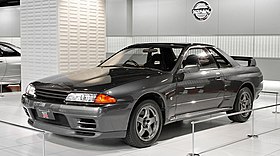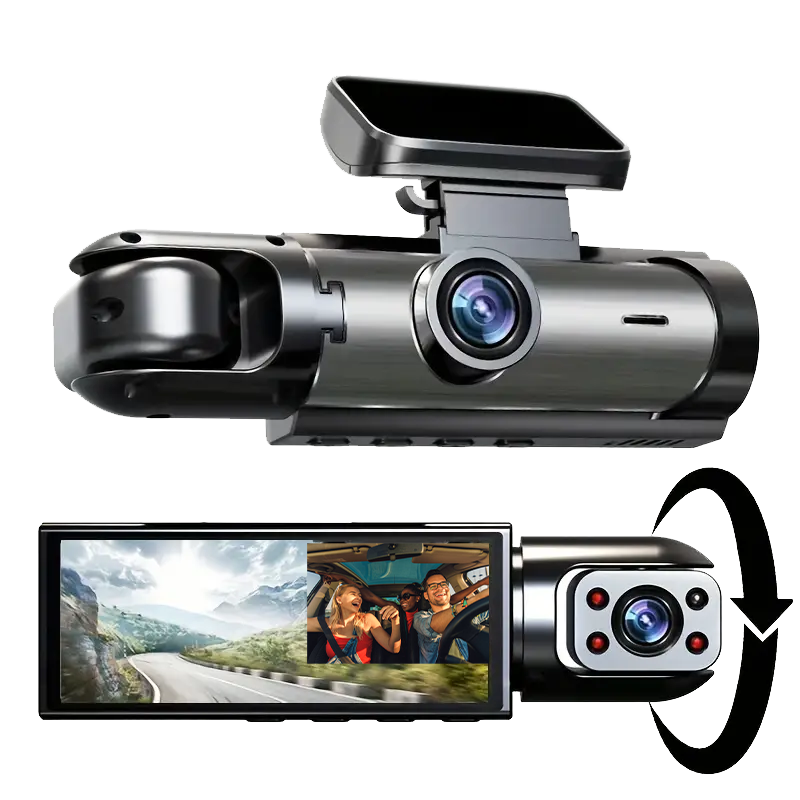
Nissan Gt-r R32 1989- 1994

After cancelling the Skyline GT-R in 1973, Nissan revived the GT-R again in 1989.
At the time Nissan was competing in Group A Racing with the Skyline GTS-R. Nissan wanted to retire the GTS-R in favor of a more competitive vehicle. The new generation GT-R, E-BNR32 chassis (commonly shortened to R32), was designed to dominate Group A racing.
| Third generation (R32) | |
|---|---|
 |
|
| Overview | |
| Production | August 1989 – November 1994 |
| Designer | Naganori Ito |
| Body and chassis | |
| Body style | 2-door coupe |
| Layout | Front engine, all-wheel drive |
| Powertrain | |
| Engine | 2.6 L RB26DETT twin-turbo I6 |
| Transmission | 5-speed manual |
| Dimensions | |
| Wheelbase | 2,615 mm (103.0 in) |
| Length | 4,545 mm (178.9 in) |
| Width | 1,755 mm (69.1 in) |
| Height | 1,341 mm (52.8 in) |
| Curb weight | 1,430 kg (3,152.6 lb) |
Nissan Kohki (Nissan's power train engineering and manufacturing facility) originally tested a twin turbocharged 2350cc bored and stroked version of the RB25 engine. This set up produced 233 kW (313 hp) and used a RWD drivetrain. Under Group A regulations, a turbocharged engine must multiply its engine displacement by 1.7, putting the new Skyline in the 4000 cc class, and requiring the use of 10-inch-wide tires. Knowing that they would be required to use 10-inch-wide tires, Nissan decided to make the car all wheel drive. Nissan developed a special motorsport-oriented AWD system for this purpose called the ATTESA E-TS. Although this assisted with traction, it made the car 100 kg (220 lb) heavier; the added weight put the GT-R at a disadvantage to other cars in the 4000 cc class. Nissan then made the decision to increase the displacement to 2600 cc, and put the car in the 4500 cc class, with the car's weight near-equal to competing cars. The 4500 cc class also allowed for 11-inch-wide tires. New engine block and heads were then developed to better match the increased displacement. The result was a 600 horsepower car. Later REINIK (Racing & Rally Engineering Division Incorporated Nissan Kohi) produced Group A racing engines between 373–485 kW (500–650 hp) depending on track conditions.
Production
This new 2.6 L all wheel drive concept was put into production as the R32 Nissan Skyline GT-R. The R32 developed 206 kW (276 hp) and 266 lb·ft (361 N·m) of torque, it had a curb weight of 1,430 kg (3,146 lbs). Nissan officially started its production run August 1989, and began its Group A campaign in 1990. Due to strict Group A homologation rules, Nissan was required to also sell a series of the Skyline GT-R that more accurately reflected the car they use in Group A racing. They called this series the Skyline GT-R 'Nismo' edition.
The Skyline GT-R 'Nismo' (identified by the model code suffix "RA") was introduced on 22 February 1990. A production run of 500 units was required under the Group A "Evolution" special regulations. An additional 60 where produced and held by Nissan to turn into race cars, giving a total production of 560 units. Its purpose was to homologate a number of changes, mostly aerodynamic and weight-saving, for use in Group A racing. Aerodynamic changes included: two additional ducts in the front bumper to improve airflow to the intercooler, a bonnet lip spoiler to direct more air into the engine bay, deeper rear spats, and an additional boot lip spoiler to provide more downforce. The 'Nismo' car deleted ABS, which was not legal in Group A, and the rear wiper, to save weight. The bonnet and front fenders were made of aluminium rather than the standard steel, again to save weight. The GT-R Nismo was only available in colour code KH2 "Gun Grey Metallic".

A rear view of an R32, showing the traditional four round taillights
The Skyline GT-R 'N1' model (identified by the model code suffix "ZN"), was introduced on 19 July 1991, and designed for home-market N1 racing with a total of 245 units eventually produced (118 of these are 'N1', 64 are 'V·Spec N1', and 63 are 'V·Spec II N1' - see below explanation of 'V.spec'). The most notable change was in the engine, which was upgraded to the R32-N1 specification. Like the 'Nismo' car it was also lightened by the removal of the ABS, and rear wiper, but for 'N1' the air conditioning, sound system, and boot carpet were also deleted, and distinctive light-weight headlights were fitted. 'N1' cars also had reinforcing for the brake master cylinder and additional brake cooling ducts under the car. All 'N1' cars were delivered with a thin layer of colour code 326 "Crystal White" paint. The result overall was a 30 kg weight savings for a curb weight of 1,400 kg.
To celebrate the success of the GT-R in both Group N and Group A racing, Nissan introduced the Skyline GT-R V·Spec ("Victory SPECification") package on 3 February 1993. The V·Spec added Brembo brakes and a retuned ATTESA E-TS system. The V·Spec was available in both 'plain' and 'N1' variants, with all V·Spec cars using the lightweight aluminium bonnet and front fenders from the 'Nismo'. The cars also replaced the standard 16" wheels with 17" BBS wheels with 225/45R17 tires. The V·Spec had a list price of ¥5,260,000.
Finally on 14 February 1994, the Skyline GT-R V·Spec II was released, with the only change being wider 245/45R17 tires. The 'plain' V·Spec and V·Spec II had a curb weight of 1,480 kg (3,256 lbs), weighing 50 kg (110 lbs) more than the standard GT-R. Total production of the V·Spec and V·Spec II was 1,396 and 1,306 units respectively.
Total production of the R32 Skyline GT-R was 43,937 units, with production starting on August 21, 1989. An above average proportion of the GT-R's were sold in white: this is likely because white is the national racing colour of Japan in international motorsport.
Production figures
- GT-R (Series 1) = 17,316
- GT-R Nismo = 560
- GT-R Australia = 100
- GT-R (Series 2) = 11,187
- GT-R (Series 3) = 11,827
- V·Spec = 1396
- V·Spec II = 1306
- N1 = 245 (GT-R N1 = 118, V·Spec N1 = 64, V·Spec II N1 = 63).
- Total = 43,937
